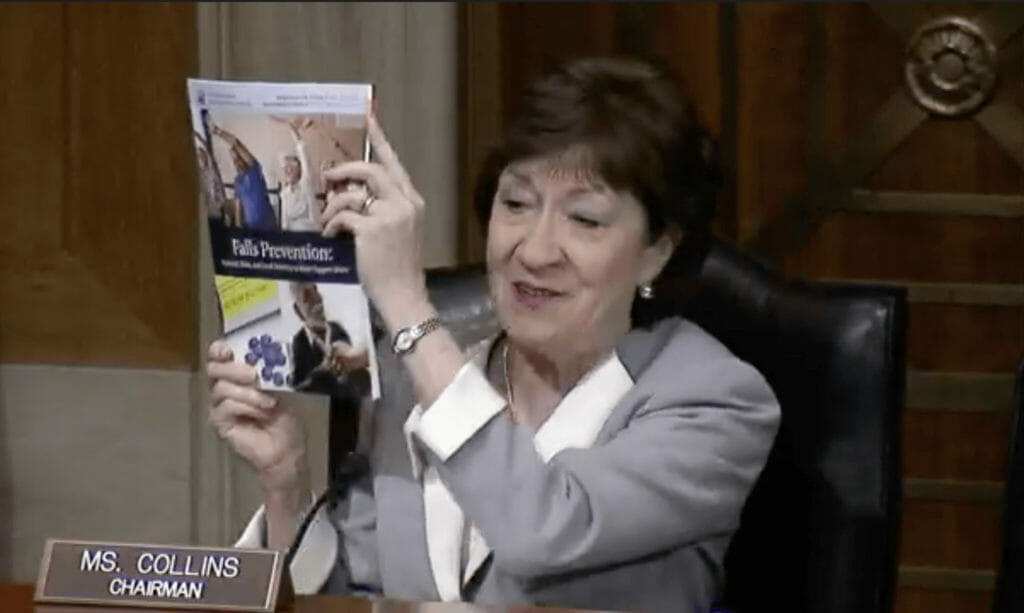
displays the Falls Prevention report issued by the committee on Wednesday.
A Senate report on falls prevention issued Wednesday has a to-do list for several federal agencies, “and we will be following up with those agencies,” said Sen. Susan Collins (R-ME), chairman of the Special Senate Committee on Aging, which released the report.
The report was a bipartisan effort, she noted during a Wednesday committee hearing on falls prevention.
It’s a matter of improved quality of life for older adults, and it’s also a matter of reducing the “tremendous economic burden” of falls, according to the 34-page report, titled “Falls Prevention: National, State, and Local Solutions to Better Support Seniors.”
“In the United States, the total cost of fall-related injuries is approximately $50 billion annually, and that is expected to double to $100 billion by the year 2030,” Collins said. “Seventy-five percent of these costs are borne by the Medicare and Medicaid programs.”
Almost 200 organizations, among them LeadingAge, answered the committee’s May request for recommendations on ways to reduce falls and related injuries.
Sen. Bob Casey (D-PA), the ranking member of the committee, said he hoped the report would lead to conversations between older adults and their care providers, more research, more funds to support home modifications, and more older adults becoming active, to reduce the risk of falling.
“I am particularly interested in sharing this report with the relevant agencies and learning how the recommendations will be implemented. Not just put in a report. Implemented,” he said.
In the report, the Aging Committee recommends that:
- The Department of Health and Human Services and other relevant federal departments develop a national education campaign to increase awareness of evidence-based falls prevention programs and preventive measures.
- The Centers for Medicare & Medicaid Services strengthen screening and referral pathways as part of the Medicare Annual Wellness Visit benefit, including taking steps to ensure greater use of the Centers for Disease Control and Prevention’s STEADI (Stop Elderly Accidents, Deaths and Injuries) resources.
- CMS improve access to, and appropriate use of, bone density testing.
- CMS pilot the CAPABLE (Community Aging in Place – Advancing Better Living for Elders) model more broadly among qualifying Medicare beneficiaries.
- Congress extend the Money Follows the Person program and encourage greater state adoption.
- CMS continue to explore pilot programs for secondary fracture prevention, including home modifications paired with supportive services, that have been demonstrated to improve use of effective screening and therapies, improve outcomes and reduce costs.
- CMS develop medication review best practices for healthcare providers to follow as part of the Medicare Annual Wellness Visit. These best practices should include information about how to conduct this review through a lens of falls prevention, the committee said.
- The Food and Drug Administration and the National Institutes of Health continue to assess the potential effects of polypharmacy and falls — specifically medication classes (for instance, anticoagulants) or specific drug combinations (for example, opioids and benzodiazepines) — and how to ensure that older adults are included in clinical trials for drugs in which they will constitute the intended population.
Collins said she has introduced several related pieces of legislation:
- The Increasing Access to Osteoporosis Testing for Medicare Beneficiaries Act, introduced in January with Sen. Ben Cardin (D-MD), would reverse cuts to Medicare reimbursements for bone density testing, which Collins said have totaled 70% since 2006, resulting in 2.3 million fewer women being tested. “As a result, it is estimated that more than 40,000 additional hip fractures occur each year, which results in nearly 10,000 additional deaths,” she said.
- The Home Health Payment Innovation Act, introduced in February with Sen. Debbie Stabenow (D-MI), would give Medicare Advantage and accountable care organizations the flexibility to waive the “antiquated” definition of “homebound” so that more people can receive such services. “Home health, especially occupational therapy, is another falls prevention tool,” Collins said, noting that Medicare Advantage has started to expand this benefit, which she called “a welcome first step.”
- The Senior and Disability Home Modification Assistance Initiative Act, introduced in March by Sen. Angus King (I-ME) with Collins as the original co-sponsor, would coordinate programs that provide home modification resources and help people age in place in their own homes.
Casey also pointed out that he and Collins are working to obtain more resources for evidence-based programming for older adults through their efforts to reauthorize the Older Americans Act.

